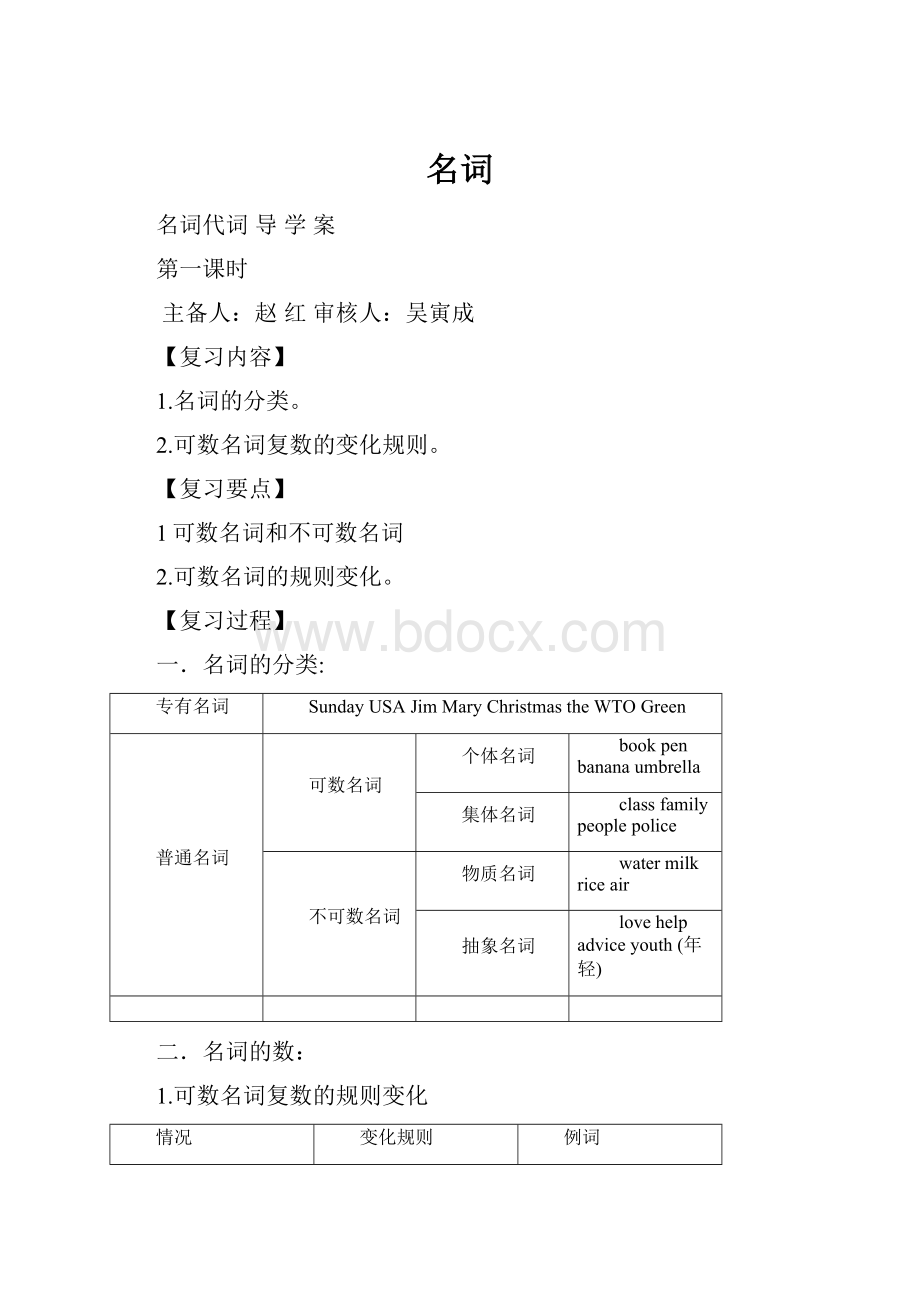名词.docx
《名词.docx》由会员分享,可在线阅读,更多相关《名词.docx(20页珍藏版)》请在冰豆网上搜索。

名词
名词代词导学案
第一课时
主备人:
赵红审核人:
吴寅成
【复习内容】
1.名词的分类。
2.可数名词复数的变化规则。
【复习要点】
1可数名词和不可数名词
2.可数名词的规则变化。
【复习过程】
一.名词的分类:
专有名词
SundayUSAJimMaryChristmastheWTOGreen
普通名词
可数名词
个体名词
bookpenbananaumbrella
集体名词
classfamilypeoplepolice
不可数名词
物质名词
watermilkriceair
抽象名词
lovehelpadviceyouth(年轻)
二.名词的数:
1.可数名词复数的规则变化
情况
变化规则
例词
一般情况
在词尾加-s
bag____boy______book______
以s.x.ch.sh结尾
在词尾加-es
watch______box______class______
以辅音字母加y结尾
把y变为i再加-es
city______baby______
以f/fe结尾
把f/fe变为v再加-es
Knife_____leaf______wolf______
以辅音字母加o结尾
有生命意义的加-es
tomato______potato______
无生命意义的加-s
Piano______zoo______radio______.
2.可数名词的不规则变化:
1)表示某国人的名词变复数
Chinese,Japanese等名词的单复数形式相同;English,Frenchman的复数形式是把字母a变成e;American,Australian,Canadian等的复数形式是在后面加-s.
Eg:
Theyarefrom______.They’re__________.
A.Germany;GermansB.Germans;Germany
C.German;GermanyD.Germany;Germen
2)改变内部元音或词尾构成复数形式的名词
man的复数形式为______,woman的复数形式为______,由man/woman构成的复合名词变复数时,两个名词需要同时变为复数形式。
foot的复数形式为______;tooth的复数形式为______;child的复数形式为______.
Eg:
Allthe_teachersenjoyedthemselvesonMarch8th,becauseitwastheirownholiday.A.manB.menC.womanD.women
3)单复数形式相同的名词
Sheep,deer,fish等名词的单复数形式相同。
而people表示人时,其本身便是名词复数,不再在其后加-s,当表示民族时,其复数为peoples;police本身是名词复数。
Eg:
Therearemore_______(sheep)inAustraliathaninJapan.
4)复合词中名词的单复数形式
数词+名词(+形容词)构成复合词时,其中名词用单数形式,但必须用连字符连接。
Eg:
Eachofushastowritea_______reporteverytwoweeks.
A.two-hundred-wordB.two-hundreds-wordC.two-hundreds-wordsD.two-hundred-words
翻译:
步行10分钟的路程一个8岁的女孩
一个10天的假期
3.学科名词形式为复数,但用作单数;还有些名词通常只用复数形式。
如:
pantsscissorsclotheschopsticksgoodsglovesglasses。
【
达标检测】
1.名词词形变化题训练
1)Tinahasgottwo_______(knife).
2)Thefive_______(German)havebeentotheGreatWalltwice.
3)Ihavesomenew_______(information)foryou.
4)Isawmany_______(Japanese)intheSummerPalace.
5)MrSmithhasthree_______(child).
6)Wouldyoulikesome_______(tomato)?
7)Wegotoschoolon______(foot)everyday.
8)Lookatthose_______(man)drivers.
9)Howmany_______(boy)arethereinyourclass?
10)Thereareno_______(class)onSunday.
2.单项选择
1)Weshouldkeepour________clean.
AtoothBtoothesCtooths
2)Howmany_________canyouseeinthebox?
-----Icanseefive.
A tomatosBtomatoCtomatoes
3)Shanghaiisoneofthebiggest_______intheworld.
A cityBcitysCcities
4)Therearealotof_______downtherebuthardlyany_______
Asheeps;peopleBsheep;peoplesCsheep;people
5)InBritain,_______areallpaintedred.
AletterboxesBlettersboxesCletterbox
6)Theteacherhasgivenus_______.
AsomeadvicesBsameadviceCanyadviceDmanyadvices
7)These_______havesavedmanychildren’slives.
A.womandoctorsB.womendoctorC.womendoctorsD.womandoctor
8)Whatisthe_____ofthe2010WorldExpo(世博会)?
-It’s“BetterCity,BetterLife”.
A.songB.themeC.custom
9)ThelandinthesouthwestofChinaisingreatneedof________.
Yes,ithasn’trainedforalongtimethere.
A.milkB.teaC.coffeeD.water
10)Theygotmuch___fromthosenewbooks.
A.ideasB.photosC.informationD.stories
【教学反思】
第二课时
主备人:
赵红审核人:
吴寅成
【复习内容】
1.不可数名词“量”的表示方法
2.名词所有格
【复习要点】
1.不可数名词表示“量”的两种方法
2.有生命的名词和无生命的名词所有格
【复习过程】
一、不可数名词“量”的表示方法
不可数名词不能用a/an表示量,可以用以下两种方法:
1.用much,alittle,little,alotof,lotsof,some,any,abitof,plentyof等表示。
2.用“数词+名词(量)+不可数名词”,如果表示复数在量词后加复数。
两杯茶四张纸三杯水
二、名词所有格
名词所有格,用来表示人或物的所有,以及所属关系。
有’s所有格、of所有格和双重所有格三种形式。
1.有生命名词所有格
1)不以-s结尾的单数名词在词尾加’s如:
王老师的书.
2)以-s结尾的复数名词,在词尾加’.如:
双胞胎的房间
3)复数不以-s结尾的名词,加’s如:
孩子们的教室
2.无生命名词所有格
用“of+名词”的结构。
如:
学校的大门
3.如果两个名词并列,并且分别有’s,则表示“两者分别有”;只在第二个名词后有’s,则表示“两者共有”。
如:
(JohnandMary)bags
(JohnandMary)bedroom
4.在表示店铺或某人的家时,名词所有格的后面常常不出现它所修饰的名词。
如:
thebarber’s(理发店)myuncle’s(我叔叔家)
5.表示时间距离等无生命名词和表示世界国家城镇等名词,可以在词尾加’s或’
如:
(步行五分钟的路程)(今天的报纸)
(十分钟车程)(一个月的假期)
6.用所有格表示节日的方法
Teachers’Day,Children’sDay。
需要注意的是除了父亲节Father’sDay和母亲节Mother’sDay,其他节日我们都用名词复数的所有格表示。
7.要特别记忆下列用to表示的所有格。
thekeytothedoor/theanswertothequestion/thebridgetotknowledge/thewaytoschool/theexittothebuilding/theentrancetothebuilding.
三、名词的修饰语
1.只修饰可数名词的:
few/afew/several/many/a(large,great)numberof等。
2.只修饰不可数名词的:
little/alittle/much/agreatdealof/abitof
3.既可修饰可数名词又可修饰不可数名词的:
alotof/lotsof/plentyof/enough/most/some
四、常见易混名词辨析
1.job/work:
job是可数名词,表示“工作、零工、职业”等,work是不可数名词,指一切非职业性的工作,如作业、干活、学习等。
2.voice/noise/sound:
voice指说话及唱歌的声音,多用于指人的嗓音。
Noise特指噪音和吵闹声。
Sound含义广泛,指一切可以听到的声音,也可用作系动词,意为“听起来”.
3.problem/question:
两者都表示“问题”。
Problem总是与“困难”相联系,它是指社会问题、教学问题等,是有待解决的问题;question总是与“疑问、质问、询问”相联系,是有待回答的问题。
【达标检测】
()1.–CanIhelpyou?
–I’dlike_____formytwindaughters.
A.twopairofshoesB.twopairsofshoeC.twopairofshoeD.twopairsofshoes
()2.–Wouldyoulikesomedrinks,boys?
–Yes,______,please.
A.someorangesB.twoboxesofchocolateC.somecakesD.twoboxesofcola
()3.Eachofushastowritea________reporteverytwoweeks.
A.two-hundred-wordB.two-hundreds-wordC.two-hundreds-wordsD.two-hundred-words
()4.–Goodnews.Wewillhavea_________holiday.
–I’veheardofit.Butit’scomingin________.
A.threedays;threedays’timeB.threedays’;threedays’
C.three-day;threedaysD.threedays;three-daytime
()5.Theygotmuch___fromthosenewbooks.
A.ideasB.photosC.informationD.stories
()6.Whenwesawhisface,weknew___wasbad.
A.somenewsB.anewsC.thenewsD.news
()7.What___lovelyweatheritis!
A./B.theC.anD.a
()8.—Wouldyoulike___tea?
—No,thanks.Ihavedrunktwo____.
A.any,bottlesoforangeB.some,bottlesoforange
C.many,bottlesoforangesD.few,bottleoforanges
()9.Heishungry.Givehim___toeat.
A.twobreadsB.twopieceofbreadC.twopiecesofbreadD.twopiecesofbreads
()10.Itreallytookhim:
___todrawthenicehorse.
A.sometimesB.hourC.longtimeD.sometime
()11.Iwouldliketohave___.
A.twoglassesofmilkB.twoglassofmilkC.twoglassesofmilksD.twoglassofmilks
()12.Canyougiveme____?
A.ateaB.somecupofteaC.acupteaD.acupoftea
()13.Pleasegiveme___paper.
A.oneB.apieceC.aD.apieceof
()14.Johnbought___forhimselfyesterday.
A.twopairsofshoesB.twopairofshoeC.twopairsofshoeD.twopairofshoes
()15._______fathersmadethemhavepianolessons.
A.PeterandAnn’s B.Peter’sandAnn’sC.Peter’sandAnn D.PeterandAnn
()16.Therearealot_______peopletodaythanyesterday.
A.of B./ C.most D.more
()17“Excuseme,areyou_______?
” “No,weare_______.”
A.American,Englishman B.American,Germans
C.American,Germen D.Englishman,Americans
()18.Allthe____teachersenjoyedthemselvesonMarch8thbecauseitwastheirownholiday.A.menB.manC.womenD.woman
()19._____roomisbigandbright.Theylikeitverymuch.
A.TomandSamB.Tom’sandSamC.Tom’sandSam’sD.TomandSam’s
()20.–WhynotgototheGreatWallthisSunday?
--I’mafraidit’snotagood______.Mostofushavebeenthere.
A.placeB.ideaC.planD.advice
()21.WhenIhurriedlygottotheairport,theladyatthewindowtoldmethattherewereno_____leftontheplane.
A.seatsB.placesC.spaceD.room
()22.Themusicmadeusthinkofthe_______ofarunningstream.
A.soundB.shoutC.voiceD.noise
()23.Iwanttobuyanew__oftrousers.A.pieceB.pairC.pairsD.不填
()24Thisisaphotoofhis_______.Isshebeautiful?
A.girlfriend B.girlfriend’s C.girl’sfriend D.girlsfriend
()25.I’vejustbeento_______.I’vegotabadcold.
A.thedoctor B.thedoctor’s C.thedoctors D.doctor’s
【教学反思】
第三课时
主备人:
赵红审核人:
吴寅成
【复习内容】
1.人称的代词、物主代词和反身代词的用法
2.指示代词和常见不定代词的一般用法
【复习要点】
1.人称代词的人称、数和格
2.形容词性物主代词和名词性物主代词
3.反身代词的数及作用。
4.指示代词this、that、these、those和常见不定代词some、any、few、little、afew、alittle、other、、theother、another、others、theothers、else、each、every、all、whole和both、no和none的一般用法
【复习过程】
一、人称的代词、物主代词和反身代词的用法
1.人称代词的人称、数和格
格数
人称
单数
复数
主格
宾格
主格
宾格
第一人称
I
第二人称
you
第三人称
hesheit
注:
人称代词做表语用宾格,在than后用主格和宾格都可以。
Eg:
Whoisknockingatthedoor?
It’s(I).
Heisolderthan(I)
Heisolderthan(I)am.
物主代词
类别
人称
数
形容词性物主代词
名词性物主代词
第一人称
单数
第二人称
第三人称
复数
第一人称
第二人称
第三人称
反身代词
人称
数
第一人称
第二人称
第三人称
单数
复数
反身代词可以在句子中作宾语,表语,同位语,意为“亲自”,“本人”
Eg:
Shetoldmethenews(she)。
二、指示代词和常见不定代词的一般用法
1.指示代词this、that、these、those。
1)this近指,that远指
2)为了避免重复提到的名词,常可用that或those代替。
Eg:
TheweatherinBeijingiscolderthaninGuangzhou.
A.thatB.thisC.it
3)this在电话用语中代表自己,that则代表对方。
Eg:
Hello!
isMary,IsJackspeaking?
A.thatB.thisC.it
2.常见不定代词
1)some与any的区别
Some、any表示一些,some用于肯定句,any用于疑问句、条件句和否定句中,表示“任何一个”“任何一些”。
Some用于表示邀请或请求的问句中,希望对方给以肯定回答。
any用于肯定句中,表示任何一个,后面接单数名词。
Eg:
Wouldyoulike(some)bananas?
Jimistallerthan(some)otherboyinhisclass.
2)few、little、afew、alittle区别
few,afew修饰可数名词little,alittle修饰不可数名词。
few,little否定afew,alittle肯定。
alittle和little也可作副词,alittle表示“有点,稍微”,little表示“很少”。
Eg:
Hehasfriendshere.
HecanspeakonlyChinese.I’mhungry.
A.few,little,afewB.few,alittle,alittle
3)other、theother、another、others、theothers、else区别
other可作形容词用,修饰名词。
theother常搭配one…theother…。
others常搭配some…others…。
another泛指三者或三者以上中的“另外一个”。
4)every与each的区别
every指整体,each指一个人的情况。
everystudent指all。
each可与of连,every不可以。
every只能做修饰词,修饰名词。
eachof+n和every